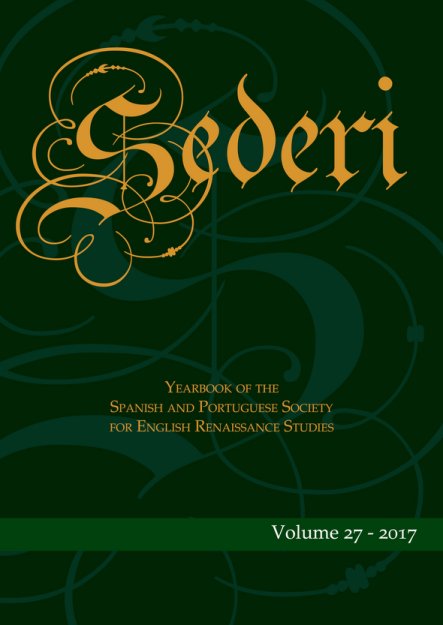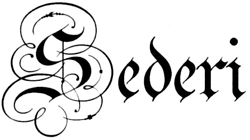
Sederi 27
Sederi 27 — 2017
EDITOR
Ana Sáez-Hidalgo
MANAGING EDITOR
Francisco J. Borge López
REVIEW EDITOR
María José Mora
ISSN 1135-7789
David J. Amelang, “From directions to descriptions: Reading the theatrical Nebentext in Ben Jonson’s Workes as an authorial outlet.” SEDERI 27 (2017): 7-26.
DOI: https://doi.org/10.34136/sederi.2017.1 Download PDF
Abstract
This article explores how certain dramatists in early modern England and in Spain, specifically Ben Jonson and Miguel de Cervantes (with much more emphasis on the former), pursued authority over texts by claiming as their own a new realm which had not been available—or, more accurately, as prominently available—to playwrights before: the stage directions in printed plays. The way both these playwrights and/or their publishers dealt with the transcription of stage directions provides perhaps the clearest example of a theatrical convention translated into the realm of readership.
Keywords: William Shakespeare; Ben Jonson; Lope de Vega; Miguel de Cervantes; stage directions.
References
Adams, Robert M. 2001. “The Staging of Jonson’s Plays and Masques.” In Ben Jonson’s Plays and Masques, edited by Richard Harp, xi–xvi. New York: W.W. Norton.
Baldick, Chris. 2004 (1990). The Oxford Concise Dictionary of Literary Terms. Oxford: Oxford University Press.
Barbour, Richard. 1998. “Jonson and the Motives of Print.” Criticism 40 (4): 499–528.
Belsey, Catherine. 2014. Romeo and Juliet: Language and Writing. The Arden Shakespeare. London: Bloomsbury.
Butler, Martin. 2012a. “The Court Masque.” In The Cambridge Edition of the Works of Ben Jonson, Vol. 1: 1597–1601, edited by David Bevington, Martin Butler, and Ian Donaldson, cxxxii–cxlii. Cambridge: Cambridge University Press.
Butler, Martin. 2012b. “Masquers and Tilters.” In The Cambridge Edition of the Works of Ben Jonson, Vol. 1: 1597–1601, edited by David Bevington, Martin Butler, and Ian Donaldson, cxliii–clxiii. Cambridge: Cambridge University Press.
Chartier, Roger. 1999. Publishing Drama in Early Modern Europe. London: The British Library.
Chaves Montoya, María Teresa. 1991. La gloria de Niquea: una invención en la corte de Felipe IV. Aranjuez: Doce Calles.
Cueva, Juan de la. 1582. Obras de Ivan de la Cveva. Sevilla: Francisco Rodríguez.
Cueva, Juan de la. 1588. Primera parte de las comedias y tragedias de Ioan de la Cveva. Sevilla: Juan de León.
Davies, Gareth A. 1995. “La Fiesta de Aranjuez: 1622.” Grama y Cal: Revista Insular de Filología 1: 53–71.
Dessen, Alan C. 1995. Recovering Shakespeare’s Theatrical Vocabulary. Cambridge: Cambridge University Press.
Dessen, Alan C. and Leslie Thomson. 2001. A Dictionary of Stage Directions in English Drama 1580–1642. Cambridge: Cambridge University Press.
Dixon, Víctor. 1989. “Manuel Vallejo. Un actor se prepara: un comediante del Siglo de Oro ante un texto (El castigo sin venganza).” In Actor y técnica de representación del teatro clásico español, edited by José María Díez Borque, 55–74. London: Tamesis.
Dutton, Richard. 1983. Ben Jonson: To the First Folio. Cambridge: Cambridge University Press.
Granja, Agustín de la. 1989. “El actor y la elocuencia de lo espectacular.” In Actor y técnica de representación del teatro clásico español, edited by José María Díez Borque, 99–120. London: Tamesis.
Greer, Margaret R. 2009. “Early Modern Spanish Theatrical Transmission, Memory, and a Claramonte Play.” In Hispanic Studies in Honor of Robert L. Fiore, edited by Chad M. Gasta and Julia Domínguez, 261–80. Newark, DE: Juan de la Cuesta.
Greer, Margaret R. 2012. “Authority and Theatrical Community: Early Modern Spanish Theater Manuscripts.” Renaissance Drama, New Series 40: 100–12.
Ichikawa, Mariko. 2013. The Shakespearean Stage Space. Cambridge: Cambridge University Press.
Ingarden, Roman. 1972 (1931). Das literarische Kunstwerk. Mit einem Anhang von der Funktionen der Sprache in Theaterschauspiel. Tübingen: Max Niemeyer.
Ioppolo, Grace. 2006. Dramatists and their Manuscripts in the Age of Shakespeare, Jonson, Middleton and Heywood: Authorship, Authority and the Playhouse. London: Routledge.
Ioppolo, Grace. 2007. “Hengist, King of Kent; or, The Mayor of Queenborough.” In Thomas Middleton and Early Modern Textual Culture: A Companion to the Collected Works, edited by Gary Taylor and John Lavagnino, 1029–61. Oxford: Clarendon Press.
Johnson, Nora. 2003. The Actor as Playwright in Early Modern Drama. Cambridge: Cambridge University Press.
Jonson, Ben. 1600. The Comicall Satyre of Every Man Ovt of his Hvmor. London: William Holme.
Jonson, Ben. 1602. Poetaster or The Arraignment. London: M.L.
Jonson, Ben. 1607. Volpone or The Foxe. London: Thomas Thorpe.
Jonson, Ben. 1608? The Characters of Two Royall Masques. The One of Blacknesse, The Other of Beavtie. London: Thomas Thorpe.
Jonson, Ben. 1616. The Workes of Beniamin Jonson. London: Richard Meighen.
Jowett, John. 2007. Shakespeare and Text. Edited by Peter Holland and Stanley Wells, Oxford Shakespeare Topics series. Oxford: Oxford University Press.
Kidnie, Margaret Jane. 2000. “Text, Performance, and the Editors: Staging Shakespeare’s Drama.” Shakespeare Quarterly 51 (4): 456–73.
Loewenstein, Joseph. 2002. The Author’s Due: Printing and the Prehistory of Copyright. Chicago: University of Chicago Press.
McJannet, Linda. 1999. The Voice of Elizabethan Stage Directions: The Evolution of a Theatrical Code. London: Associated University Presses.
McKerrow, R. B. 1931. “The Elizabethan Printer and Dramatic Manuscripts.” The Library IV 12 (3): 253–75.
Miñana, Rogelio. 2000. “Representar lo irrepresentable: La gloria de Niquea de Villamediana.” In El texto puesto en escena: estudios sobre la comedia del Siglo de Oro. En honor a Everett W. Hesse, edited by Bárbara Mujica and Anita K. Stoll, 113–20. London: Tamesis.
Parker, Brian, and David Bevington. 1999 (1983). “Introduction.” In Volpone, by Ben Jonson, 1–29. Manchester: Manchester University Press.
Pfister, Manfred. 1988. The Theory and Analysis of Drama. Cambridge: Cambridge University Press.
Profeti, Maria Grazia. 1999. “Escritura, compañías, destinatarios: un teatro de la ambigüedad.” In Cervantes y la puesta en escena de la sociedad de su tiempo, edited by Catherine Poupeney Hart, Alfredo Hermenegildo, and César Oliva, 55–75. Murcia: Universidad de Murcia.
Rijsberman, Marijke. 1987. “Forms of Ceremony in Ben Jonson’s Masques.” In Ben Jonson, edited by Harold Bloom, 223–38. New York: Chelsea House.
Rose, Mark. 1993. Authors and Owners: The Invention of Copyright. Cambridge, MA: Harvard University Press.
Shergold, N.D. 1967. A History of the Spanish Stage: From Medieval Times until the End of the Seventeenth Century. Oxford: Clarendon Press.
Stern, Tiffany. 2009. Documents of Performance in Early Modern England. Cambridge: Cambridge University Press.
Syme, Holger Schott. 2008. “Unediting the Margin: Jonson, Marston, and the Theatrical Page.” English Literary Renaissance 38 (1): 142–71.
Tassis y Peralta, Juan de [Conde de Villamediana]. 1991. La Gloria de Niquea: una invención en la Corte de Felipe IV. Aranjuez: Doce Calles.
Vega, Félix Lope de. 1634. El castigo sin venganza, tragedia de frey Lope Felix de Vega Carpio. Madrid: Pedro Lacavalleria.
Vega, Félix Lope de.1635. El castigo sin venganza. In Veinte y vna parte verdadera de las comedias del fenix de España Frei Lope Felix de Vega Carpio, 91–113v. Madrid: Diego Logroño.
Weis, René. 2012. “Introduction.” In Romeo and Juliet, by William Shakespeare, 1–116. London: Bloomsbury.
Werstine, Paul. 2012. Early Modern Playhouse Manuscripts and the Editing of Shakespeare. Cambridge: Cambridge University Press.
